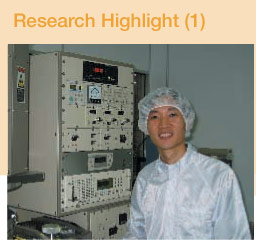|
Research Outline:
Flash Electrically Erasable and Programmable Memory (EEPROM) are presently one of the most popular forms of nonvolatile memories. Conventionally, nonvolatility in the form of 10-year data-retention time can be achieved by making the tunnelling oxide thickness of these devices to be greater than 7nm. However, by incorporating a thick tunnelling oxide, it greatly compromises the write and erase speed of these devices. In order to overcome the limitation imposed on the tunnelling oxide thickness, some memory devices use hot-electron injection mechanism to improve the write speed. However, the erase speed is still limited by the low tunnelling current through the tunnelling oxide.
It has recently been demonstrated that memory-cell containing nanocrystals embedded within the gate dielectric exceeds the performance limitation of a conventional floating gate device. The attractive characteristics of replacing conventional floating gate with nanocrystals created a great interest in this area.
In our work, a tri-layer structure, which mimics the conventional floating gate oxide, is synthesised through RTO and cosputtering techniques. Germanium nanocrystals of controllable sizes are successfully synthesised through annealling and the manipulation of the thickness of the tri-layer. Capacitor based and transistor based memory structures have been fabricated to investigate the charge storage capability of these germanium nanocrystals. The nanocrystal memory device is found to exhibit high endurance characteristics and also enable multi-bit operation in a single transistor structure.
Research Experience:
My research experience in the SMA programme has been both challenging and fulfilling. Interacting with both my NUS and MIT supervisors have indeed made the course of my research more rewarding as I am able to obtain more comments from different perspectives.
I have also benefited immensely from my MIT stay. During my stay, I used the Microtechnology Lab (MTL) facilities and had the chance to interact with other MIT students. These interactions have been invaluable and helped me to foster many friendships in the process.
Even though I will be graduating soon, I believe that the relationships and friendships that I have found in the SMA programme will be everlasting. |




